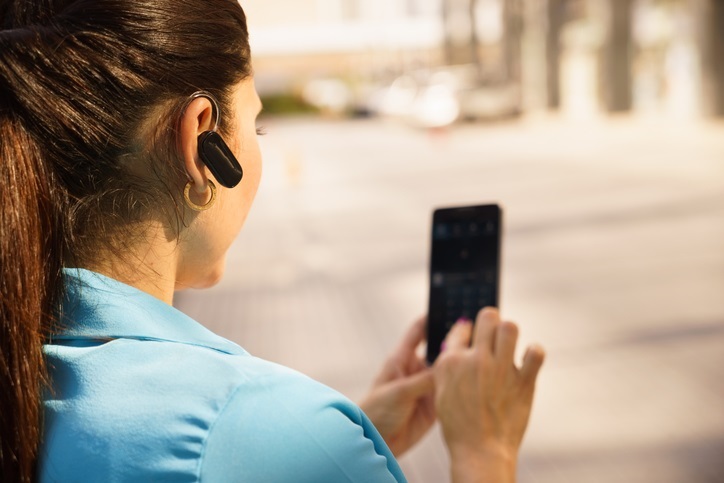Bluetooth

Bluetooth Contents
- What is Bluetooth?
- Origins of the Name
- Bluetooth Version
- Bluetooth Range
- Bluetooth Frequency
- Bluetooth Transmission Security
- Bluetooth Protocols
- Bluetooth Smart and Smart ready


Bluetooth is ideal for fast and simple data transfer at small distances. With a phone or computer, it is possible to communicate with a fitness tracker, a smart watch or wireless speakers.
What is Bluetooth?
Bluetooth is the standard for wireless communication linking two or more electronic devices, such as tablets, mobile phones, earphones, fitness trackers and more. A Bluetooth connections to a PC can be established with Bluetooth USB adapters. It is used to transmit audio, video and other files and their signal is also used by security locators. Bluetooth was invented in 1994 by the Swedish telecommunications company Ericsson, who were researching an alternative for cable connections for mobile devices.
Origins of the Bluetooth Name
The name Bluetooth comes from Denmark, where King Harald Bluetooth reined in the 10th century. He left his mark on history by uniting several tribes throughout Scandinavia and ruling over Denmark and Norway. The title was given to commemorate the efforts to facilitate communication and dialogue. The Bluetooth symbol is a combination of the runes that create Harald Bluetooth's name.

Versions of Bluetooth
The Bluetooth Special Interest Group , a private enterprise, spends its efforts developing new verions of the technology; it is sometimes inaccurately referred to as a nonprofit organization. The company owns trademarks, licenses, and develops new Bluetooth versions, but does not primarily deal with trade or production. It was founded in 1998 by Ericsson, IBM, Intel, Toshiba and Nokia. Today, Kirkland is home to over 10,000 companies. Check out our easy-to-read tables for each Bluetooth version:
| Bluetooth version: | First version release: | New vs. previous versions: | Alzak adds: | Speed: | Standard range: |
|---|---|---|---|---|---|
| Bluetooth 1.0: | 1999 |
| This technological start-up remained unpredictable, because the compatibility of individual devices was inconsistant. | 721kb/s | ? |
| Bluetooth 2.0: | 2007 |
| Transferring files required patience. Everyone still preferred a USB cable or memory card for uploading music and videos. | 2.2Mbit/s | 10m |
| Bluetooth 3.0: | 2009 |
| Version 3 was finally designed for bulky data transfers of videos, music files, and photos. | 24Mbit/s | 10m |
| Bluetooth 4.0: | 2010 |
| The Bluetooth 4 speed focus should not replace the previous version - they coexist and complement each other as needed. | 1Mb/s | 50m outside, 10m inside |
| Bluetooth 5.0: | 2016 |
| Bluetooth 5 is a step towards the future - more precisely, the fully functional Internet of Things. | The choice between 125kbps, 500kbps, 1Mbps and 2Mbps - the lower the speed, the higher the range. | Up to 240m outdoors, 40m inside - depending on speed. |
Bluetooth Range
- The range of Bluetooth depends on the version of the technology.
- The latest Bluetooth 5.0 version reaches up to 240m outdoors and 40m indoors - depending on transfer speeds.
- The broadest version of Bluetooth 4.2 on average reaches 50m outdoors and 10m inside.
- Data transfer works based on radio waves transmission.
- The main limitation of Bluetooth is its relatively small range.
- Bluetooth signal barriers are diminishing.
- In addition to establishing a connection, data transmission requires that all devices are within reach at all times.
Bluetooth Frequency
- The radio part of Bluetooth operates in the same frequency band as WiFi, called the 2.4GHz ISM.
- In Europe, the bandwidth may reach up to 2483.5MHz.
- There are 79 radio channels of 1MHz in the ISM frequency band.
- Bluetooth bridges up to 1600x per second to maintain signal stability.
Bluetooth Transmission Security
The security of the data being transferred and the devices themselves is a central concern for Bluetooth traffic, and usually they are authorisation based - the user must confirm the connection when pairing the device. Linked devices then generate a key by which they encrypt transmitted data. While there are procedures to challenge viruses spread this way, the threat significantly reduces the relatively short signal range and the constant improvement of the Bluetooth standard.
Bluetooth Protocols
Bluetooh is a standard word, but it can also be referred to as a protocol. Protocols are sets of rules for device communication. The Bluetooth protocol itself contains a number of smaller quotes in quotes. Under LMP, for example, Bluetooth conceals a radio link management protocol, L2CAP provides data transfer and streaming, ACD TP or AVD TP protocols and video and audio controls, and a whole host of other solutions.

Thanks to Bluetooth, it is possible to communicate between virtually all electronics. It is, therefore, an important component of smart home appliances and the Internet of Things, where shorter distances will need a much more demanding WiFi signal.
Bluetooth Smart and Smart Ready
- In order to connect two Bluetooth devices, they must be paired in compatible profiles.
- We recommend that you try to link the device directly when purchasing.
- Bluetooth versions 4.0 and higher have been labeled Smart Ready and support pairing with smart devices.
Bluetooth is an important and often integral part of today's electronics with great potential for the future. Thanks to low energy consumption and better features, this technology is developing the most comprehensive ecosystems of interconnected appliances and devices.

